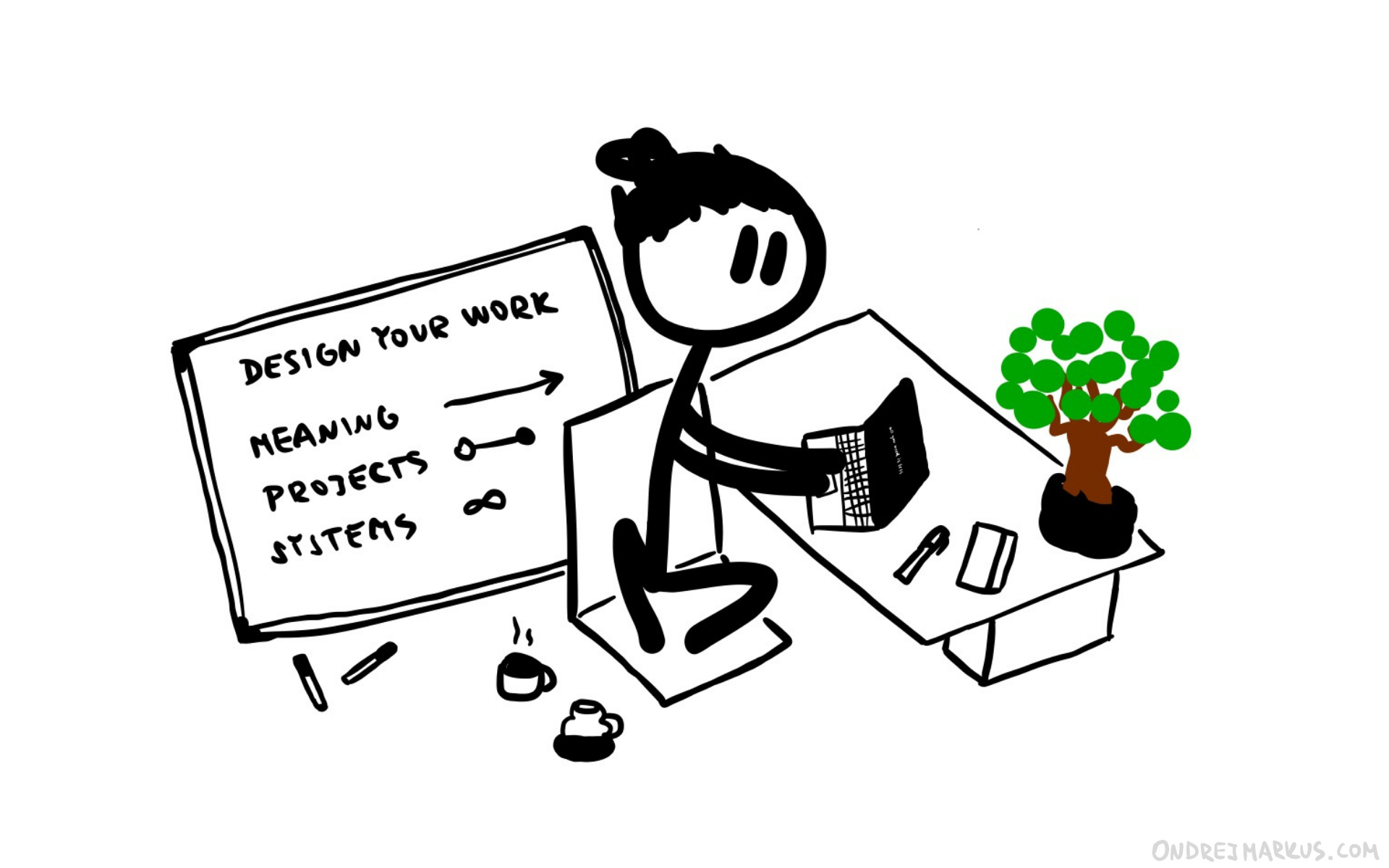

Hey there,
I failed again to write this reflection in a day. Oh well. Drawing stickmen is hard work.
This time, I want to talk about how:
Feel free to go nuts and jump around to what’s interesting to you. Or, if you trust in my design, let’s start here.
Most of my work is based on my belief that people should make a living doing something they enjoy.
Why? Because doing work you enjoy every day feels fantastic.
I might not have cracked the code to get rich, but one thing I’m already good at – I’m enjoying the shit out of my work. And if I had to pick just one, I’d pick what I have.
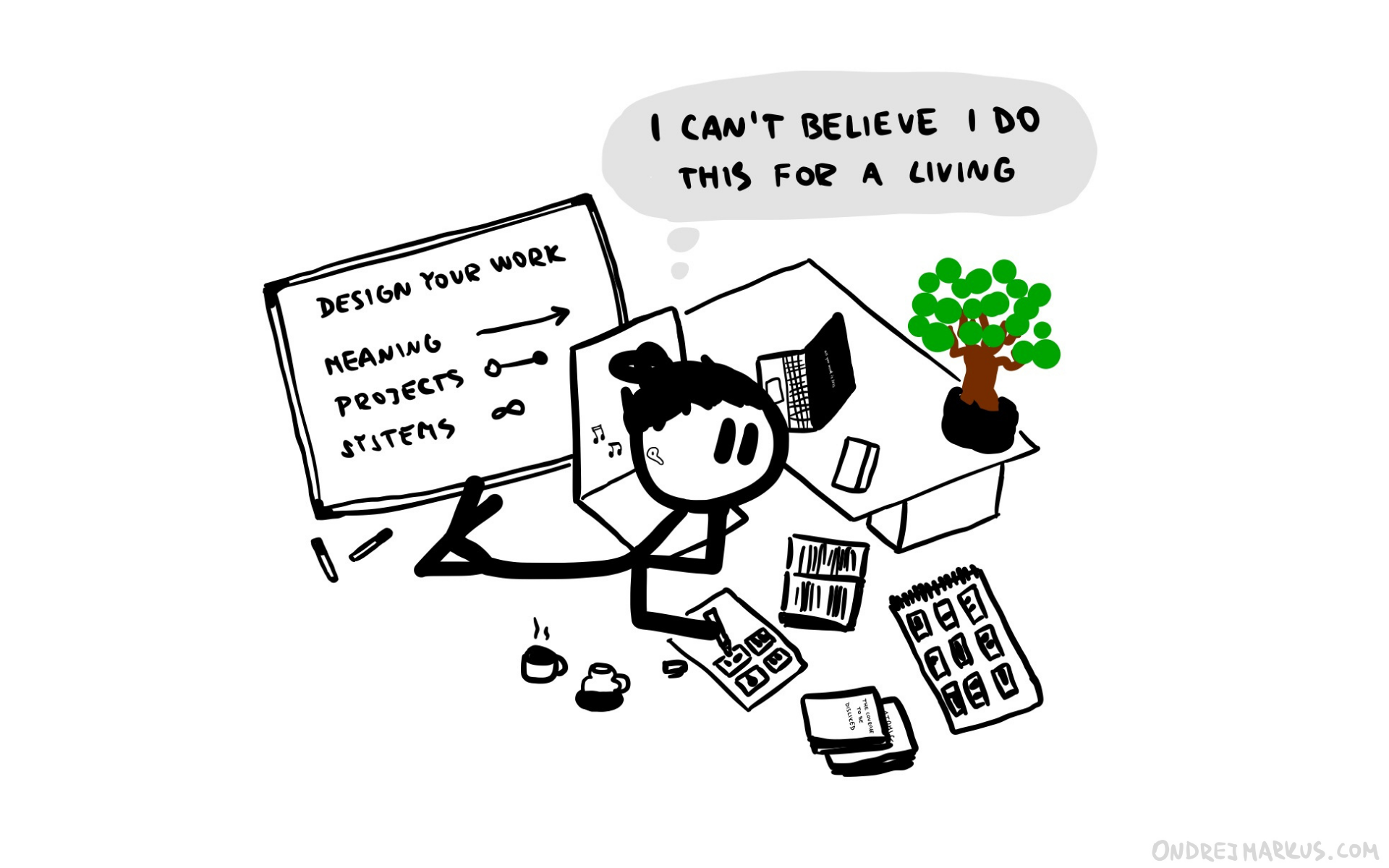
Do work you enjoy doing just because.
It’s one of the best feelings I know, and I want to help people find their version of it. Just imagine if people didn’t have to suffer through 8 hours of their day but actually worked on something they wanted to do.
I had my fill of hating Mondays for 10+ years in school. Nevermore. The heavy feeling in your belly when you have to go somewhere you don’t want to be, do something you don’t want to do, around people you don’t want to be around. I’ve had enough. Life is too short for that.
And yeah, sure, every work is sometimes frustrating when it’s difficult, or when you have to deal with jerks, or you get lost for a while searching for the next project. That’s okay. That’s a part of the game. It wouldn’t be fun if it was too easy.
But if you have to have some problems to avoid boredom, why not choose problems you like to have?
Overcoming obstacles is fun if you love the process – when your days end with you feeling: “Damn, today was awesome. I could just do this forever on repeat, and I’d be happy. I don’t need anything else.”
That’s priceless.
I mean, it’s probably not true because we need change and growth, but it feels incredible nonetheless. It’s worth chasing this feeling. And If I could give this as a gift to every human on the planet, I would. This world would be so much better if everyone was doing what they love.
That’s why I’m creating a new course to take people through everything they need to design a better work-life.
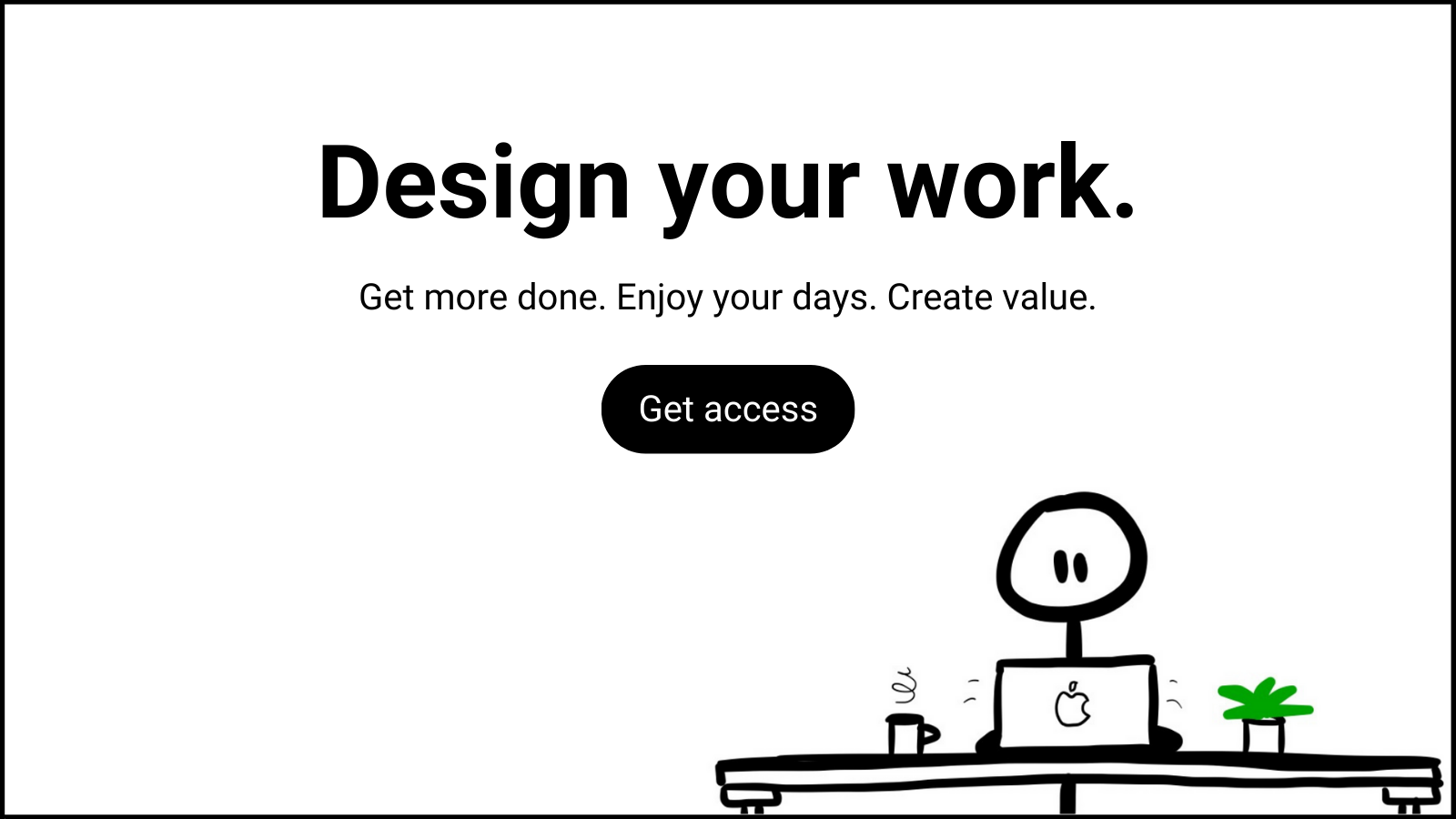
MetaSprint.net (website in progress)
That’s right. Design, not find. I believe in creating more than finding what you love to do. There’s no reason to suffer through your work when you can be its designer.

Get things under control. Be more mindful about what you do, how, and why.
So what does it mean to “design a better work-life”?
Well, I look at this question on 3 levels:
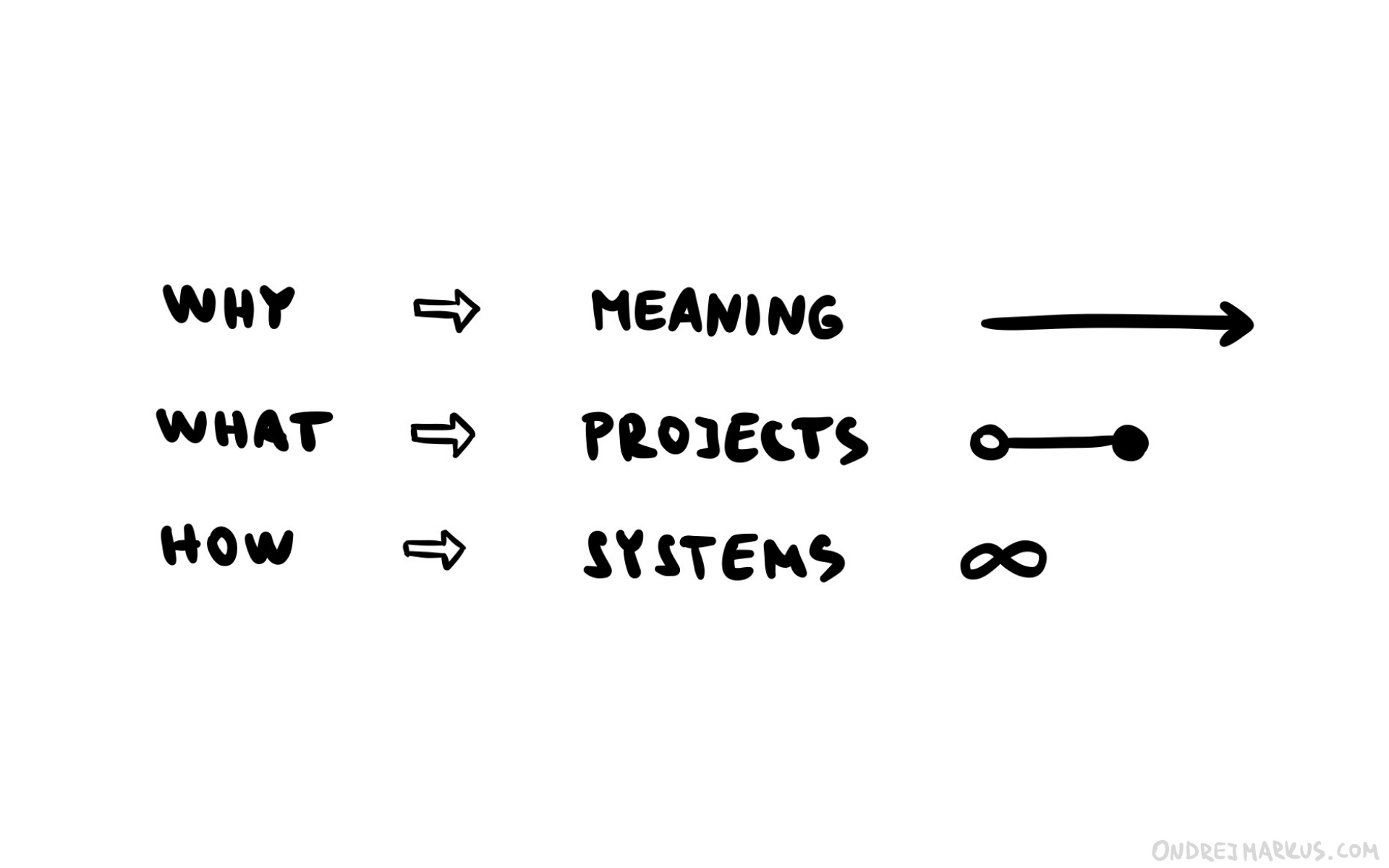
These 3 parts cover the area of work from long-term visions to daily routines – from the big picture to everyday details.
I want this to be the only career course anyone will ever need.
Online courses tend to be crap. Statistics say that most people don’t finish them, and I’m not surprised. I never finished most of the online courses I bought.
So what makes a good online course?
Right now, I have tons of material I’m working full-time to develop into a course that checks all of the above. It’s a huge challenge I’m enjoying while crackling under at the same time.
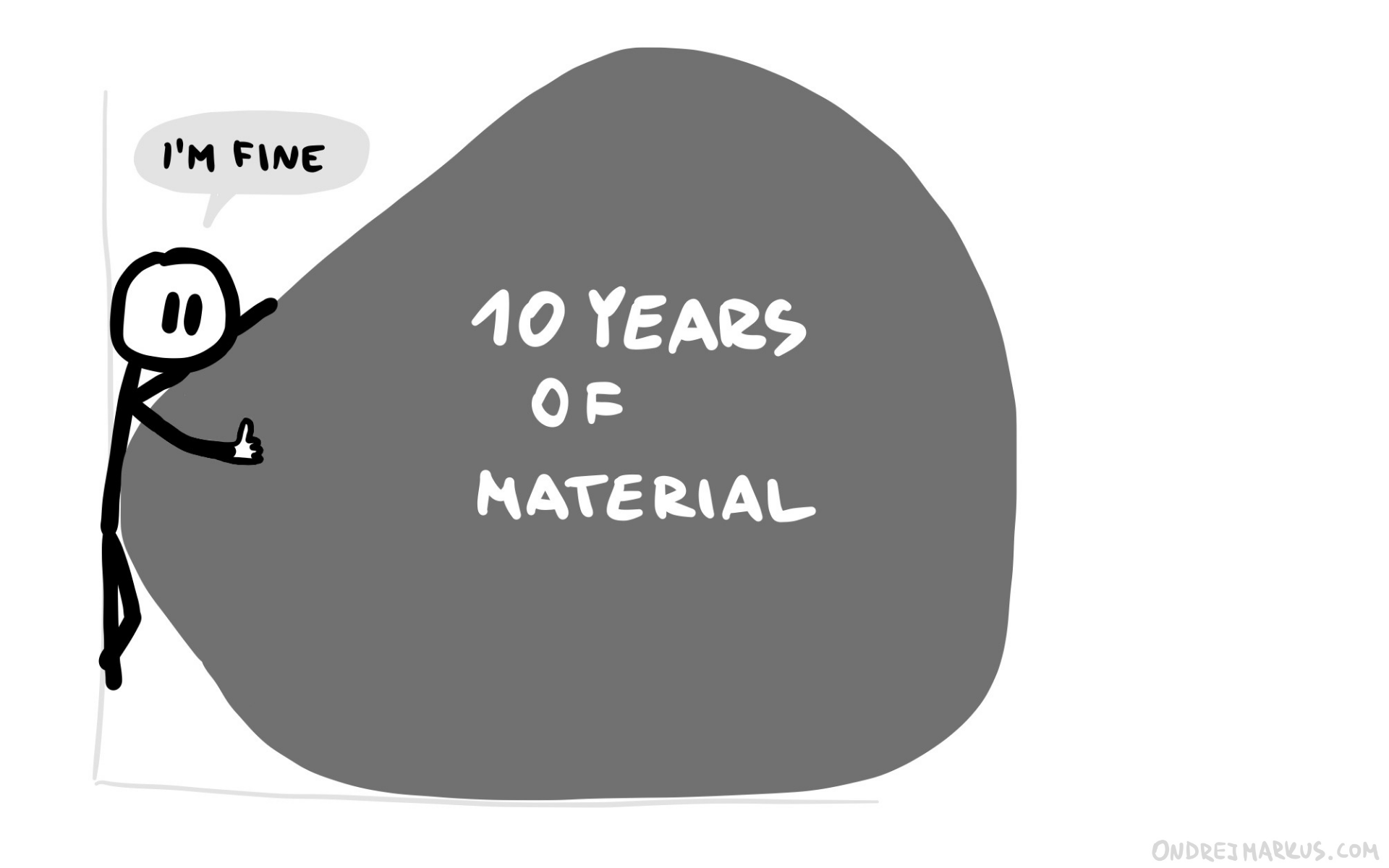
There’s a lot of stuff out there.
So I’m thinking a lot about how to pull this off without losing my shit in the process. My plan is to test and improve the concepts for lessons as tweets and articles before I commit to making high-maintenance content like high-quality videos.
That means I will:
This fast iteration process should help me find the best ideas and how to communicate them effectively. Plus, even if I decide to change my plan and do something else, this loop will create value for me (in learning) and others (in content) as it happens. I can’t lose this way.
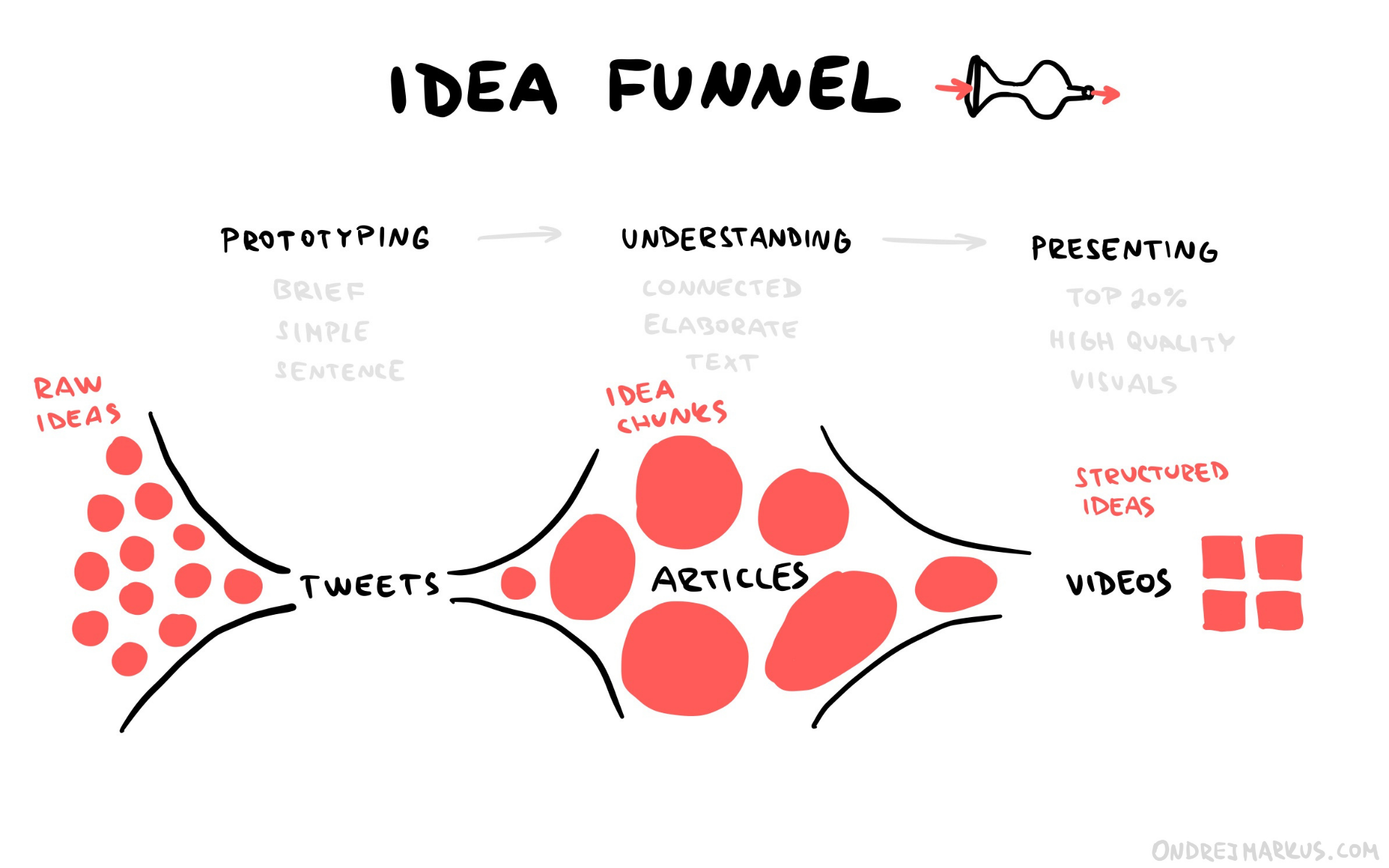
This almost makes sense. (It’s work in progress.)
My current vision for the final product is a self-paced course with 30+ short videos where I explain and visualize the lessons as stories in about 5 minutes. Plus there will be instructions with worksheets and templates you can use to start applying the stuff immediately.
I’d like to structure the course to be always easy to continue. The next step would only take a few minutes. But it also needs to be actionable, so people actually DO things that impact their lives, which is hard to accomplish anywhere, and even more so in an online course.
It’s a big challenge. But just thinking about this project makes me chuckle with excitement. I want to design the best career course on the internet.
If you want to help me, check out the landing page I just published. It’s an early draft that’s going to change many times. So don’t be afraid to rip it apart, and tell me what does and doesn’t work for you. I want your opinion.
And if you like my vision for the course, you can subscribe here to get a special offer when it’s ready. I’ll never forget early supporters. (I have a special list.)
Moving on.
Skillful storytelling fascinates me. That’s why I started paying more attention to people who are exceptional at it.
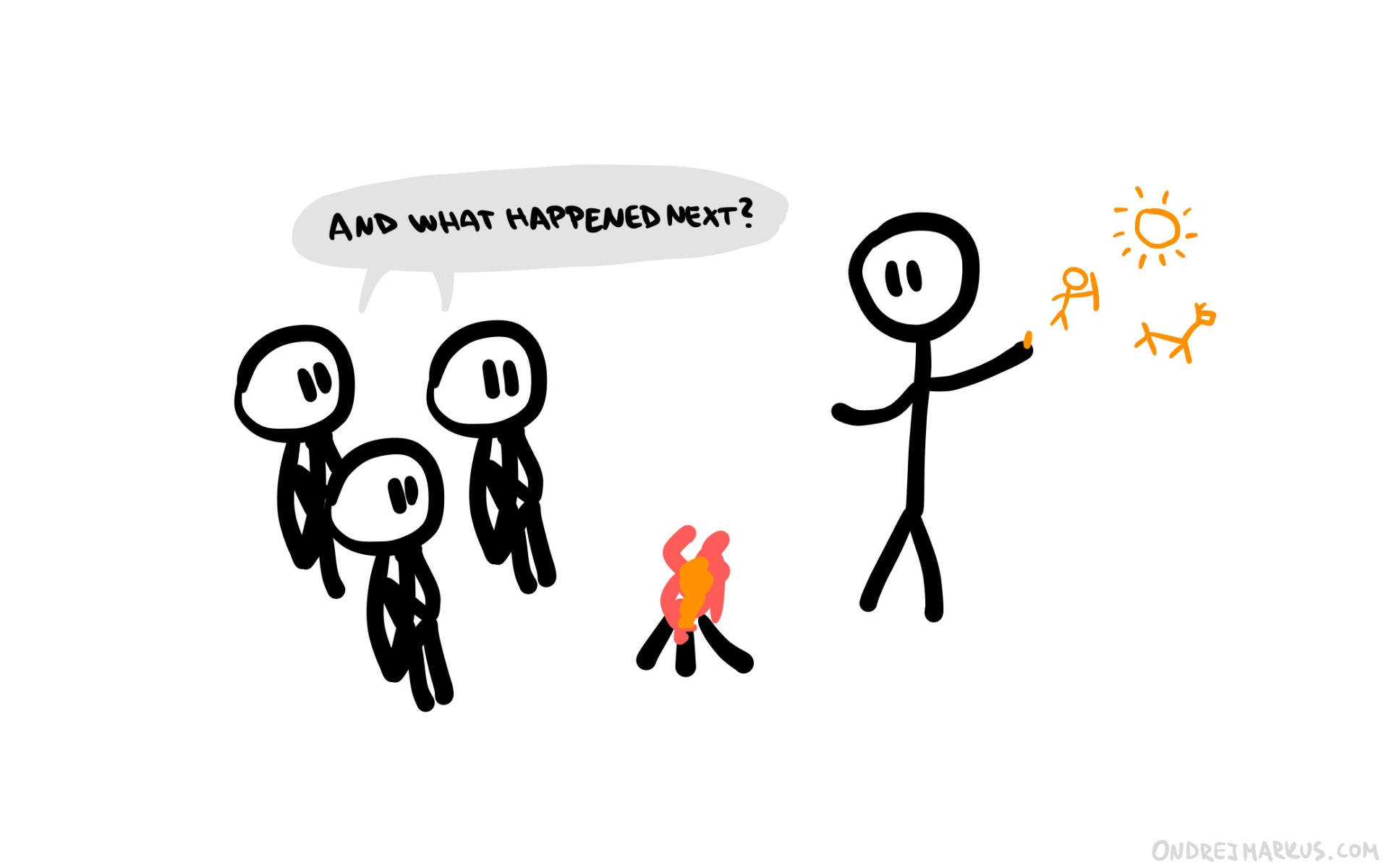
We are born storytellers. We just need to practice.
I’m looking at how standup comedians think about storytelling. I’m looking at Pixar and how they craft their stories. And I’m looking at writers who are masters of using storytelling as a vehicle for what they’re trying to say (like the maker of Rick and Morty).
Storytelling is everywhere.
But I don’t want to give you a lecture about storytelling. I just started learning about it. So what I’m going to do, is share the best material for becoming a better storyteller I found this month.
Storytelling is one of the most crucial skills for creating value in any form. It helps you to be more entertaining and persuasive. Not even mentioning the fact that telling good stories makes you a better companion in almost every social situation. Everyone loves to be around a good storyteller.
Get better at storytelling. It’s worth your time, no matter what you do.
I’m trying to build a network of peers and fans around my work on Twitter. But I’m still at the very beginning – an introvert bootstrapping a network from scratch. Fun stuff.
So what’s the problem?
The problem is, I’m not enjoying Twitter as much as I’d want to. And this is a problem because I’m shit at doing what I don’t enjoy doing. Once I don’t enjoy something, it usually fails horribly.
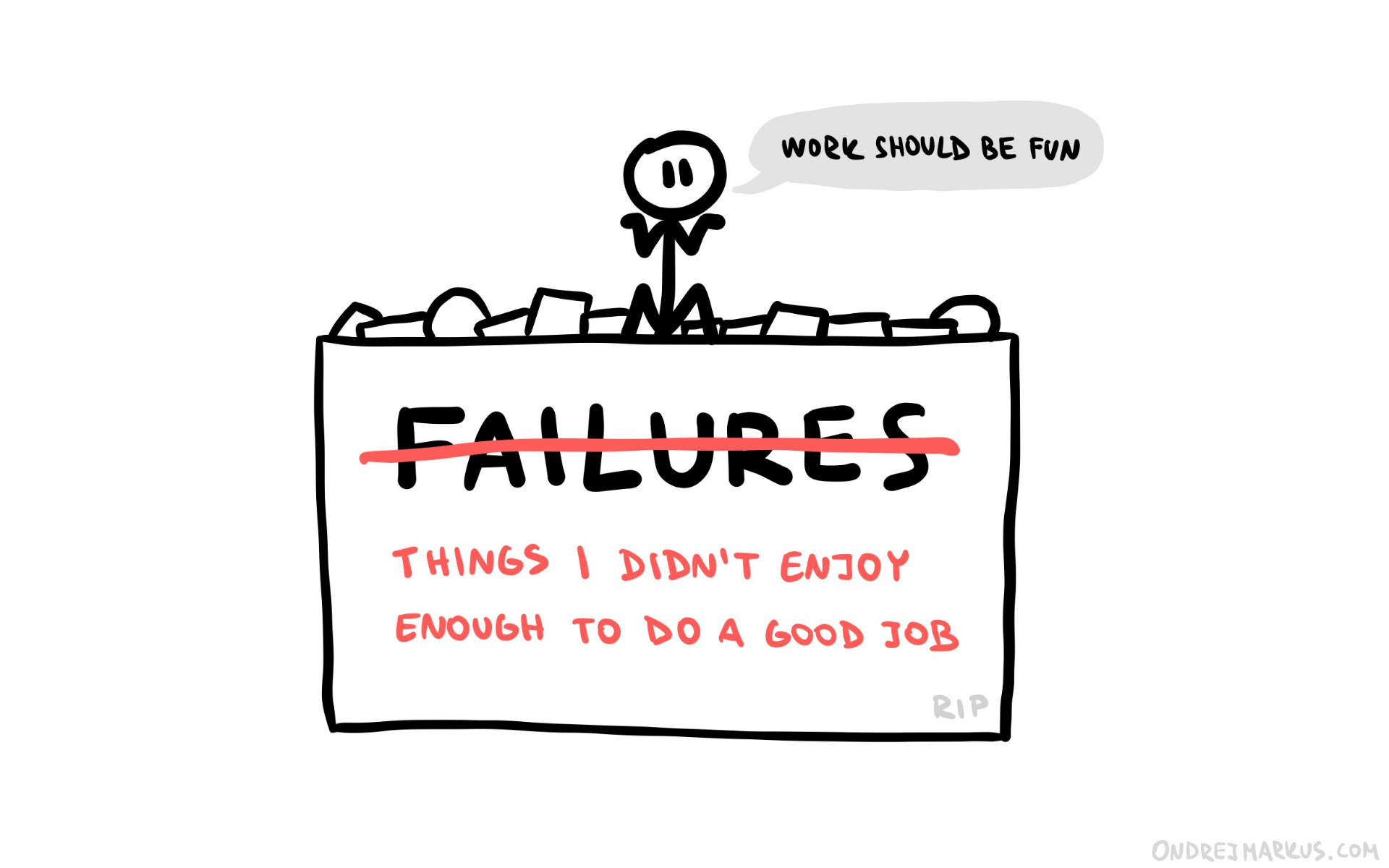
I’m gonna die defending this hill. Work should be fun.
But I still believe in Twitter as a place to share your work, and I don’t want to quit – at least not yet. And that means I need to find a way to enjoy my daily Twitter experience.
To build a network on Twitter that will help you succeed as an online entrepreneur, you need to commit a lot of time and energy over months and years. Building relationships is a marathon, not a sprint.
It’s particularly challenging if you’re an introvert like me who, on most days, doesn’t feel like socializing with strangers. Turning strangers into familiar faces takes effort I’m not always willing to spend.
So, honestly, I didn’t do a great job on Twitter over the last month. It was too hard. My day-to-day feelings fluctuated between two extremes:
So, I feel torn.
You see, the good days are giving me the hope that I can design the experience to be more reliably enjoyable. The good stuff is out there somewhere. I just need to filter out the noise.
Of course, sometimes I’m just not in the mood, and that’s fine. That’s just who I am. But I want to tip the balance towards an experience that makes my day better, not worse.
I think it’s like what they say about relationships: You have to have at least 5 positive interactions to 1 negative. If you do, let’s get married. If not. Bye-bye, nice to meet you.
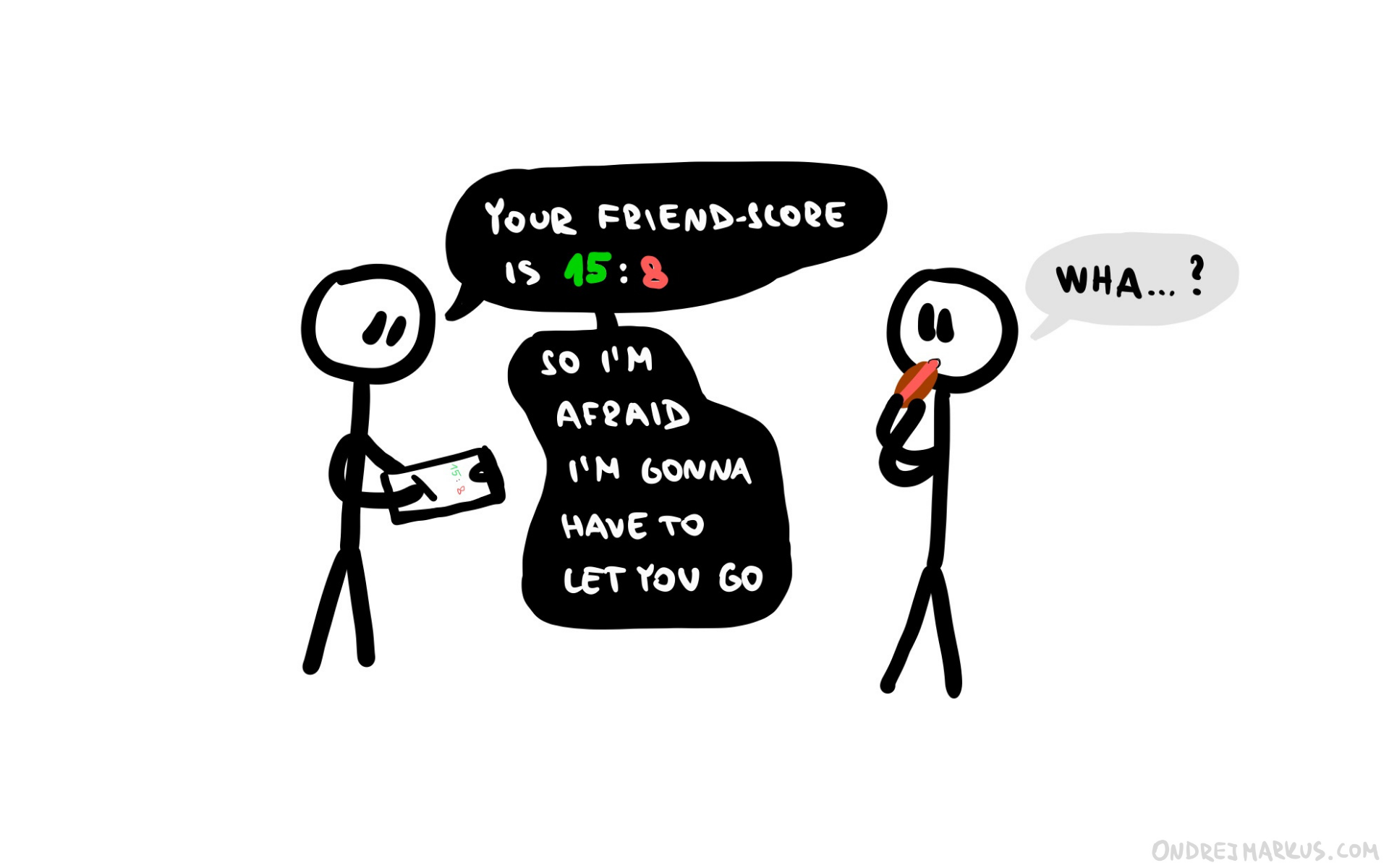
Good math makes good friendship.
So what did I am I doing to improve my Twitter experience?
Any ideas? (Email me.)
Now, let’s look at the numbers.
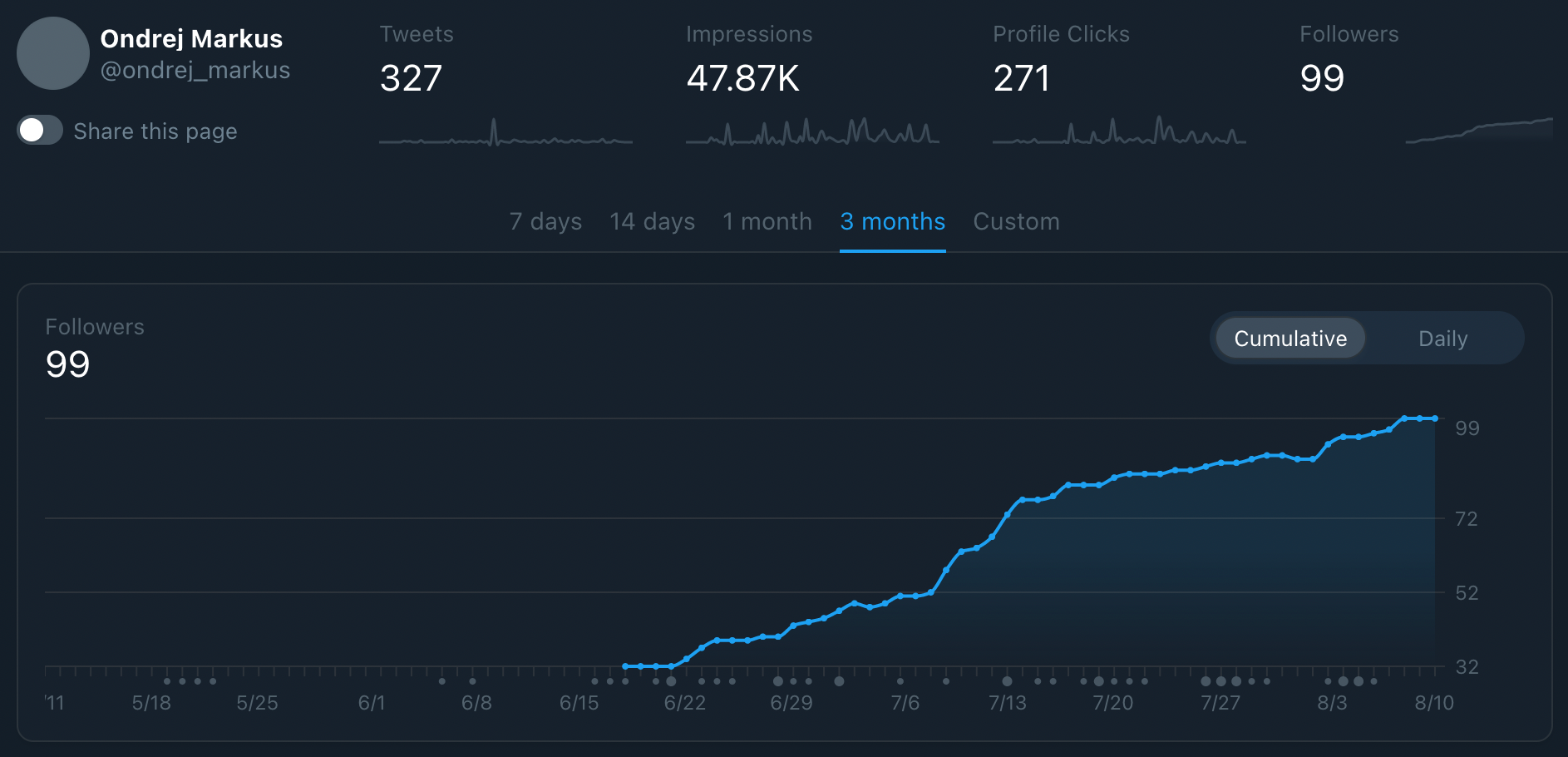
I use Typefully.app
Since I started playing the Twitter game about 2 months ago, I went from practically 0 followers to 99 (today).
Around 30 of those are meaningful connections (meaningful = people I talked to 1:1 for more than a quick “hello”).
The rest are people who followed me probably because they saw my tweets or comments. And either none of us reached out to one another, or they don’t have DMs open, or they didn’t reply to me when I said hi.
I get it. Some people prefer a passive Twitter experience – watching only, no talking. Fine with me. A part of me would like it too. But that wouldn’t help me achieve what I am there to do.
What I’m going to try next:
I don’t care that much about growing fast on Twitter. I mean, it would be nice and all, but I’m not willing to put the work in right now. I’d prefer to find 100 people who really want to hear what I have to say and talk about it with them.
I will focus on tweeting consistently, writing articles, and slowly attracting people interested in what I do.
The big thing to build up my Twitter for will be launching the course. But we will come back to it in a month or two. There’s more work to be done.
Alright. That’s it for July. There was more, you know, but I try to keep these emails crunchy and talk only about what’s interesting.
Now, if you think: “Damn, I enjoyed this.”
Firstly: I’m glad, thanks.
Secondly: It would mean the world to me if you spread the word about the new course on your platform of choice.
Just copy the URL (MetaSprint.net) and tell people something like: “Check this shit out. It’s coming for you.” Or whatever you like to say. I don’t know how people do this. :D
Have a good one.
Byyye.